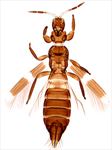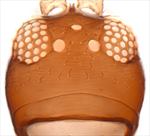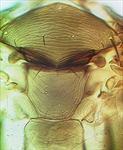
Female

Antenna (phase contrast)

Antenna (bright field)

Head

Meso & metanota

Female sternite VII

Fore wing

Tip of fore wing (phase contrast)
Both sexes with fore wings bearing two transverse dark bands, apical ring vein pale. Body and legs brown, antennal segment I pale, II–III largely yellow; abdominal segment X variable but usually much paler than VIII–IX. Antennae 9-segmented, segment III with linear sensorium almost 0.5 as long as segment, IV with sensorium more than half length of segment and curved distally; segments V–IX forming a single unit with V considerably longer than VI–IX. Head and pronotum with no long setae; eyes prolonged on ventral surface, maxillary palps 3-segmented. Fore tarsus apically with stout recurved ventral hamus. Metanotal reticulation weak. Marginal setae on sternites arising at or close to margin; sternite VII paired accessory setae arising well in front of margin.
Male tergites IV and V with paired dorsal tubercles; setae at base of paired claspers on tergite IX shorter than clasper, with stout curved seta lateral to clasper.
A. ericae is a member of the Eurasian species-complex that includes A. fasciatus, although the males have a pair of very stout setae anterolateral to the bifurcate claspers on the ninth abdominal tergite, as in A. collaris. About 105 species are placed currently in the genus Aeolothrips. Most of these are from the Palaearctic Region (including the Mediterranean, Iran and northern India, but with five species extending through eastern Africa to South Africa), with about 30 species from the Nearctic (mainly western USA). Only one species of this genus is known from the Neotropics, A. fasciatipennis described from Chile, but Mound & Marullo (1996) indicate this is probably the same as A. fasciatus.
Usually found on flowering Erica or Calluna [Ericaceae], but also various Fabaceae. Presumably a facultative predator in flowers, with a mixed diet of pollen and the larvae of other thrips.
Widespread across western Europe, and introduced to North America. Recorded in California only from two females taken in March 1995 at Casper, Mendocino Co.
AEOLOTHRIPIDAE
Aeolothrips ericae Bagnall
Aeolothrips ericae Bagnall, 1920: 60
Aeolothrips mulleri Priesner, 1920: 51
Aeolothrips nobilis Priesner, 1921: 21
Aeolothrips speciosus Melis, 1933: 169
Aeolothrips aterrima Hukkinen, 1935: 88
Aeolothrips albotarsata Keler, 1938: 87
Aeolothrips lucidus Oettingen, 1944: 40
Alavi J & Minaei K. (2018) Studies on the genus Aeolothrips (Thysanoptera: Aeolothripidae) in Iran, with a key to species. Zootaxa 4446 (3): 343–360.
Mound LA & Marullo R (1996) The Thrips of Central and South America: An Introduction. Memoirs on Entomology, International 6: 1–488.
Mound L, Collins D & Hastings A (2018) Thysanoptera Britannica et Hibernica. A guide to British thrips. Lucidcentral.org, Identic Pty Ltd, Queensland, Australia. https://keys.lucidcentral.org/keys/v3/british_thrips/
zur Strassen R (2003) Die terebranten Thysanopteren Europas und des Mittelmeer-Gebietes. Die Tierwelt Deutschlands 74: 1–271.